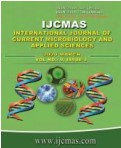


 National Academy of Agricultural Sciences (NAAS)
National Academy of Agricultural Sciences (NAAS)

|
PRINT ISSN : 2319-7692
Online ISSN : 2319-7706 Issues : 12 per year Publisher : Excellent Publishers Email : editorijcmas@gmail.com / submit@ijcmas.com Editor-in-chief: Dr.M.Prakash Index Copernicus ICV 2018: 95.39 NAAS RATING 2020: 5.38 |
Fluorescent pseudomonad bacteria, a major constituent of Rhizobacteria, enhance the plant growth through diverse mechanisms. The association between plant and fluorescent pseudomonad bacteria contributes to the successful thriving of plants in extreme environments featured by moisture stress. The enzyme has been noticed in a few numbers of bacteria and which helps the plant growth and development during biotic and abiotic stress situations with the depletion of stress levels of ethylene production in plant system. Fluorescent pseudomonads drawn broad attention as production of secondary metabolites, phytohormones, siderophores, enzymes, antibiotics, HCN and volatile compounds. They can be promoted in low input sustainable agricultural practices. The present experiment revealed that fifty-one efficient bacterial isolates obtained from drought prone rhizosphere soils of groundnut. Isolated strains were also tested for further drought stress screening by poly ethylene glycol 6000 at 0 % (-0.05 MPa), 10 % (-0.65 MPa), 20 % (-1.57 MPa), 30 % (-2.17 MPa) and 40 % (-2.70 MPa). Thirty-seven bacterial isolates were further found to have an enzyme 1-aminocyclopropane-1-carboxylate (ACC) deaminase activity which improved plant growth during stress conditions. Twelve isolates were found to be positive for IAA production. The positive isolates taken and screened for the presence of Fluorescent pseudomonads using King’s B media.
 |
 |
 |
 |
 |